AMD Launches Mobile Kaveri APUs
by Jarred Walton on June 4, 2014 12:01 AM ESTAMD Kaveri FX-7600P System/CPU Performance Preview
After the briefing, we were given a chance to benchmark a prototype Kaveri notebook for a few hours. That wasn't enough to run our full suite of laptop benchmarks, and battery testing in particular is something we couldn't perform. I did run some quick simulations of battery life; however, the prototype systems are optimized more for performance rather than power, so the results weren't really meaningful. We'll have to wait for retail laptops with Kaveri APUs before we can really see what sort of battery life to expect, but AMD claims there should be a decent jump in mobility compared to Richland.
The test systems were more of a proof of concept rather than anything you could actually sell. The keyboard was okay if a little mushy, but the touchpad in particular I found a bit lacking, and build quality was mediocre as well. The screens at least were good quality 1080p 15.6" touchscreen panels, and that was enough to get us benchmarking. I snapped a few pictures of the laptop that you can see above. In terms of other core specs, the laptop had 8GB of DDR3-1866 RAM and a Samsung M.2 256GB SSD.
For our purposes here, we're including the AMD Kaveri Prototype, AMD Trinity Prototype, and AMD Kabini Prototype laptops as a starting point. For retail laptops, we have the MSI GX60 with Richland A10-5750M APU (but only a single 8GB SO-DIMM, unfortunately), the Sony VAIO Pro 13 (i5-4200U), and the Acer V7-482PG (i7-4500U + GT 750M). The Acer is the only laptop equipped with a discrete GPU, so we wanted to see how Kaveri stacks up against such a system. You can compare additional results against Kaveri in Mobile Bench, of course.
Again, these numbers are only preliminary – the drivers for the GPU were slightly older (without Mantle support enabled yet), and there were occasions of odd behavior where other editors had scores that didn't match up with our results until after a reboot. We were not able to run each benchmark multiple times, so most of these results are from a single run. AMD is keen to talk about the GPU improvements with Kaveri, but I also wanted to see what has happened on the CPU side, so we'll start with our CPU/system benchmarks.
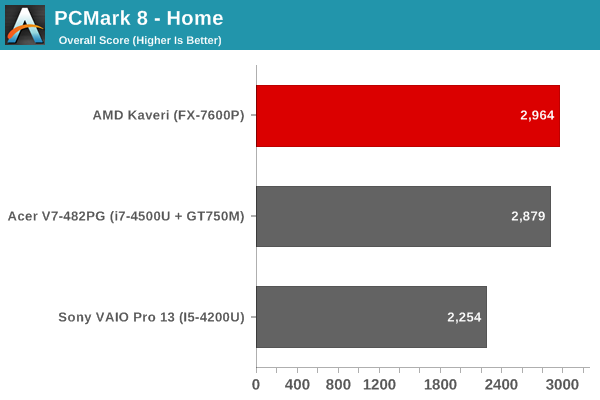
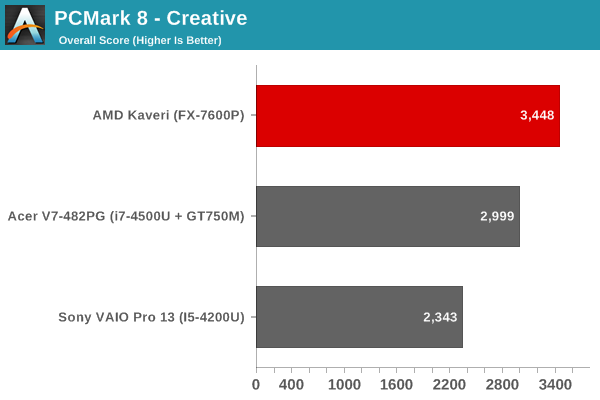

We don't have results for PCMark 8 for many of the systems, and the VAIO Pro 13 seems to be underperforming for some reason, but otherwise we get a pretty good idea of where things fall in terms of overall performance. Note that PCMark 8 is now OpenCL accelerated, which can improve performance quite a bit on AMD APUs. The result is that AMD actually takes the lead in the Home and Creative suites, but without more time benchmarking the system I wouldn't try to draw too many conclusions. Storage subsystem performance can still have an enormous impact on PCMark results, and the V7-482PG has to get by with an SSD caching solution. The VAIO Pro 13 on the other hand just seems to score a bit lower than I'd expect, so again take these scores with a grain of salt.
Moving on to other benchmarks, I also ran PCMark 7 as it doesn't have any OpenCL acceleration and will provide a better view of traditional application performance. Hopefully we'll continue to see improvements in the use of OpenCL (GPU) acceleration and over time PCMark 8 scores will be more indicative of real-world performance, but right now there are plenty of situations where having a GPU does very little for performance.

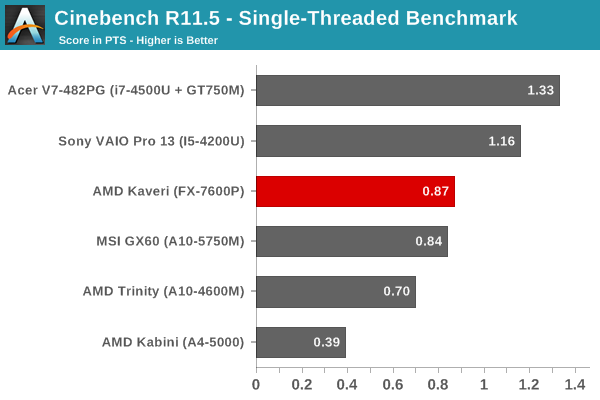
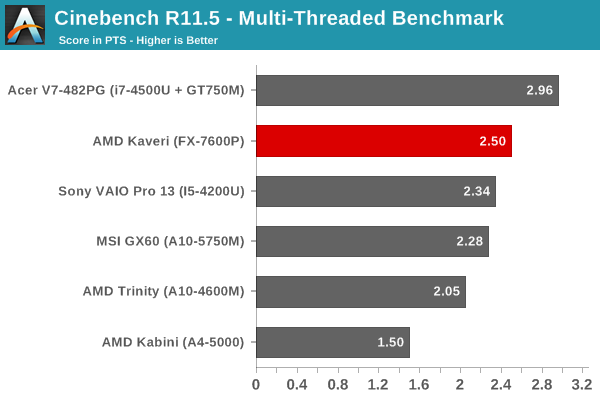
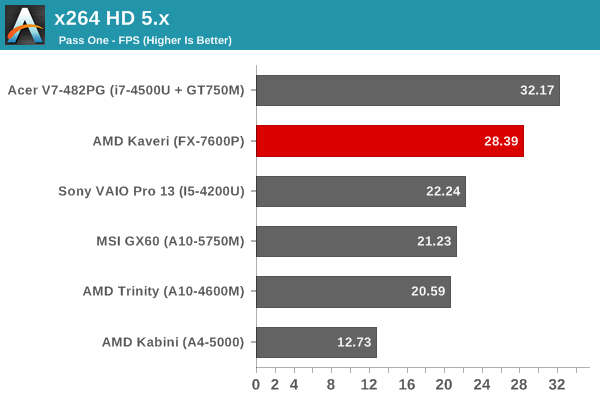
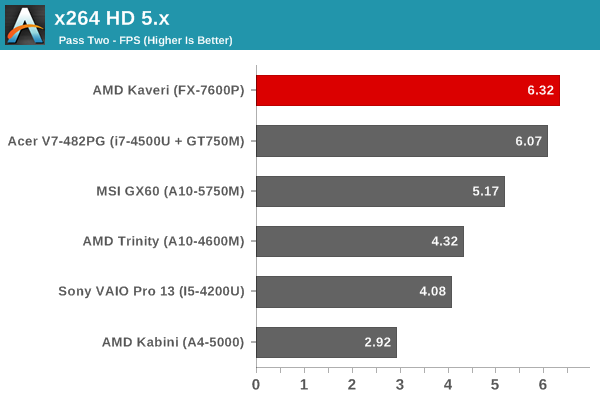
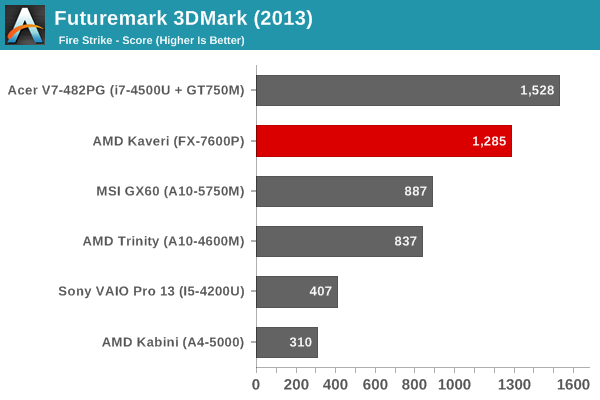
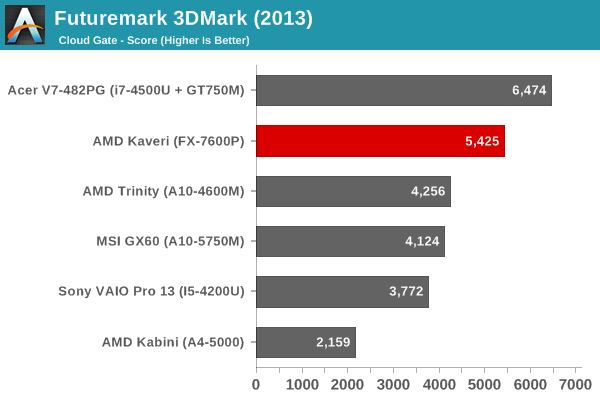

Somewhat surprisingly, Kaveri actually takes the lead in the very demanding second pass of the x264 HD 5.0 encoding test. Granted, we're looking at a 35W APU vs. 15W ULV CPU, and Intel's 37W quad-core parts would certainly retake the lead (and cost quite a bit more), but at least Kaveri is showing some real improvements over Richland in these tests. As noted above, PCMark 7 doesn't have any OpenCL optimizations so the gap between AMD and Intel is a bit wider.
Moving to the 3DMark results, Kaveri shows an impressive increase in performance over the Trinity/Richland GPU, which is expected. Intel's iGPU – particularly in the ULV system shown here – just doesn't stand a chance. While we are potentially TDP limited for the ULV Intel parts in graphics tests, my experience is that 3DMark hits the GPU much more than the CPU, so the GPU gets the lion's share of the TDP. I'll try to run some tests on other Haswell systems using the iGPU to verify the above results, but outside of the HD 5000 and Iris parts, I wouldn't expect Intel's iGPU to be too much faster than what we're seeing here.
Overall, an Intel CPU with a discrete GPU is still faster than Kaveri in most areas, and a quad-core i7-4702QM would really distance itself from AMD's Kaveri…but the quad-core i7 CPUs tend to start at around $350, so there's not much point in discussing that comparison. My personal feeling is that unless you're really pushing a laptop hard, most of the modern CPUs/APUs are plenty fast. I wouldn't want a Kabini APU, but Trinity/Richland, Ivy Bridge, Kaveri, and Haswell are all going to be fine for everyday use.
The more important element for me with a laptop (or desktop) is that I simply can't stand using conventional hard drives for the primary storage device any longer. Given the choice between an AMD Kaveri APU with a 256GB SSD (the Crucial MX100 is sure looking nice!) and pretty much any other laptop that has pure HDD storage, it's a no brainer for me. In fact, laptop manufacturers would do their customers a great service if they took the cost savings of AMD's APU vs. Intel's CPU and put that into a decent SSD solution rather than chasing the lowest possible price!


_thumb.jpg)
_thumb.jpg)
_thumb.jpg)
_thumb.jpg)
_thumb.jpg)








125 Comments
View All Comments
Gigaplex - Wednesday, June 4, 2014 - link
"The comparison is for CPUs in the same price range, not CPUs in the same TDP range, obviously."For a mobile platform? I couldn't disagree more. Power consumption directly affects battery life, and you either need to spend more on the battery (negating cost savings) or just live with less runtime.
The_Countess - Sunday, June 15, 2014 - link
you can buy a LOT of extra battery capacity for the premium intel charges for its ULV CPU's. (a whole laptop battery replacement can be had for as little as 50 euro's.)furthermore most of the time, and most of the power, will be spent on idle, which is completely separate from the TDP. and again TDP is not power draw. the 2 don't even have to be related. a TDP is quit often set for a whole RANGE of CPU's so OEM's can make 1 laptop designed to one TDP and put a whole host of CPU's in it.
so without some actual power draw tests doing various tasks this speculation is useless.
Galatian - Wednesday, June 4, 2014 - link
It's even a bigger joke when they test Intel chips with the worst possible iGPU (HD4400). If you have to use 15W chips vs. a 35W chip in comparison at least take the best of the bunch aka one with a HD5000. Apple offers the MacBook Air for an incredible cheap price, while having a high builds quality. Though for AMD to get into designs like that. When you have a processor that cuts corners, than your entire product has to cut corners IMHO. I mean I can pay 600€ for a cut corner AMD notebook or I can spend 300€ and be a happy camper.Also dedicating so much text about why SSD are important doesn't really bode well for the product reviewed here...
hamoboy - Wednesday, June 4, 2014 - link
Well, Tom's Hardware takes a 35W Intel chip to compare their Kaveri test system to, and the Kaveri still absolutely smokes the Intel competitor in gaming. What Jarred is getting at in his reviews I think, is that it's no use for AMD to put out 19/17W chips if OEMs aren't going to bother making anything worth a damn with them inside.The comment about OEM's hamstringing AMD laptops is quite true, so many AMD laptops come out with single channel RAM and slow mechanical HDDs, but people attribute the low performance to the APU being slow, when for most purposes, any new mainstream chips coming from Intel or AMD are more than enough.
Galatian - Wednesday, June 4, 2014 - link
It doesn't "absolutely smoke" the Intel competition:1.) DOTA2 is actually faster on the Intel chip
2.) Frametime variance is better on the Intel chip through out (although admittedly probably moot point, since abysmal FPS anyway)
3.) It's a HD4600, so still not the better Intel iGPUs
Fergy - Wednesday, June 4, 2014 - link
If you take an Intel cpu with HD5000 (that is the one with the expensive L4 cache right?) doesn't that make it really really expensive so totally outside the market where AMD is putting these chips?System1: kaveri $500
System2: intel HD5000 $700
Consumers compare on price not on performance.
Galatian - Wednesday, June 4, 2014 - link
No. The HD5000 is actually what's Inside the MacBook Air for example, so a 15W ULV part. For 35W you have the Iris 5100 (which is still without the "expensive" eDRAM). Only some of the 45W chips have the Iris Pro 5200.I only have Apple as a reference but their notebooks are of high quality, don't cut corners and are actually affordable. The MacBook Air starting at 899€ and the 13" rMBP at 1299€. I would argue that an AMD equipped notebook which doesn't cut corners is not going to be much cheaper. In the end the price difference will be a question of weather you want the more powerful Intel chip or not.
Also I think AMDs claim of OpenCL performance I blown out of proportion. Their advertisement slides when Kaveri lunch actually had faked stats for Intels iGPU OpenCL performance. I did my own tests and received muh higher numbers. You can also check the PCMark and 3DMark websites to see that Intel was and is much better then what AMD wants you to believe. That is not to say that they are not better, I just think it needs to be put into better perspective if you really want to make the trade off (Better GPU for OpenCL but worse CPU)
nico_mach - Wednesday, June 4, 2014 - link
Your price comparison is off, though. Apple gets the highest end GPU chips from Intel, and then charges LESS than competitors. That Sony i5 was MORE expensive than the MBA or even the Mac Pro. Apple doesn't make cheap hardware, but they haven't had overpriced hardware in years (or no more than competitors).But I agree in principle, it just isn't going to happen for AMD. The HP sleekbook was easily the best looking 'ultrabook' and it was only briefly available (not that it was good, but lots of poor laptops do better). AMD is used by the OEMs only to keep Intel honest - and that's why they launched on desktop first. Intel doesn't really care about desktop, so AMD wisely chose that first, where they can get some enthusiasts as well as a few modest OEM wins.
I have an AMD chip and it was a good budget choice for a basic PC. But the OEMs are closer to adopting ARM en masse (HP has joined Samsung with ARM chromebooks now) than AMD. I'd like to think HSA might turn it around, but I think at this point Intel's guns are bigger than AMD's and they have more of them. Perhaps Lenovo will keep going vertical and scoop them up to move to China. They already have red logos, after all.
hamoboy - Wednesday, June 4, 2014 - link
1) That Dota2 result is so wide it seems like a result of driver non-optimization, than the Intel GPU actually being better.2) Like you said, it's a moot point.
3) The best Intel GPUs are found in chips that are way way out of AMD's price range. A true apples to apples comparison is between affordable midrange chips to affordable midrange chips, and that's what Tom's Hardware did.
Galatian - Thursday, June 5, 2014 - link
I agree on your first two points but beg to differ on the later. Not everybody is shopping with a set amount of money, most usually look what will 100€ more or less get me or what can I get in a given thermal envelope. I would argue for example that the HD5000 will turn out faster in the 19/15 W TDP envelope next to AMDs chips.Also I think most people are forgetting that AMD won't be competing with Haswell but with Broadwell which is close to be released.
Now this is not to say it's a bad chip, I just don't get the hype that's being made. I think the trade off worse CPU for better GPU is not worth it for most customers. HUMA and HSA still has to show how powerful it could be (and I have my doubts if it will ever get widespread attention) and people easily forget that Intel also supports OpenCL, so every software optimized for it will also run faster on Intel hardware.
In the end AMD chips - in my eyes - still remain the budget choice (if at all) and this is why you probably won't see many non cut corners notebooks.